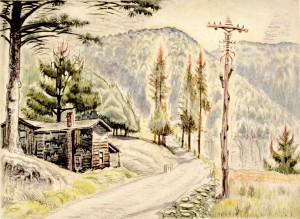 Charles Burchfield (1893–1967)
Charles Burchfield (1893–1967)
Morning in the Alleghenies, 1954
Watercolor and conté crayon over graphite on paper, 12 7⁄8 x 17 1⁄2 inches
Gift of the Reverend Richard L. Hillstrom in honor of Les Bendtsen
Burchfield is one of the artists, along with Edward Hopper (1882–1967), most identified with the American Scene, and artist Guy Pène du Bois (1884–1958) used that term to refer to Burchfield’s images of provincial America as early as 1924. The artist was known especially for his intense, passionate watercolors, the medium in which he virtually exclusively worked. Burchfield’s earliest career concentrated on landscapes that often drew from childhood memories or fantasies, while in his middle period he explored urban images of streets and buildings. This watercolor is from a third period in which he returned to landscapes, investing them with energy and a kind of “ecstatic poetry” (to quote an important scholar of the artist, Matthew Baigell). Burchfield was interested in pantheism and his landscapes in particular seem to crackle with an electrical presence that could be seen as the divine. He, however, was also taken by the more mundane quality of the electrical humming of utility poles and in his writings discussed the “singing of the telegraph poles” and noted that one could easily “invent a multitude of symbols to represent the humming of a telegraph pole….” The pole in the right of this composition has linear patterns that seem to emanate from it, a feature of numerous of the artist’s works, such as his Song of the Telegraph Pole, a watercolor on which he worked in 1917 and then, in 1952, reworked and expanded (by adding additional pieces of paper, a frequent practice in the third part of his career). Morning in the Alleghenies is one of a number of works the artist made in the Allegheny Mountains in the western part of Pennsylvania. Another is a watercolor of similar dimensions, though vertically aligned, in the Art Institute of Chicago, titled Midsummer in the Alleghenies (1955). Both may have been drawn on location and then finished with the addition of watercolor in Burchfield’s studio, as is suggested in the Hillstrom Collection work by lightly penciled color notations in the composition.
Text from the catalogue for the exhibition The Eight, The Ashcan School, and The American Scene in the Hillstrom Collection, presented in the Hillstrom Museum of Art February 25 through April 21, 2013.